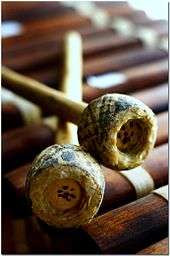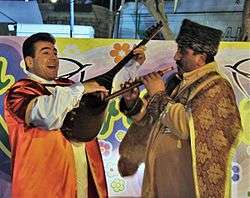Tar (Azerbaijani instrument)
| Craftsmanship and performance art of the Tar, a long-necked string musical instrument | |
|---|---|
|
Azerbaijani tar performer Meshadi Jamil Amirov | |
| Country | Azerbaijan |
| Reference | 671 |
| Region | Europe and North America |
| Inscription history | |
| Inscription | 2012 (7th session) |
Craftsmanship and performance of the tar and the skills related to this tradition play a significant role in shaping the cultural identity of Azerbaijanis. The Tar (Persian: تار) is a long-necked plucked lute, traditionally crafted and performed in communities throughout Azerbaijan and Iran. Tar features alone or with other instruments in numerous traditional musical styles. It also considered by many to be the country’s leading musical instrument.
In 2012 art of Azerbaijani craftsmanship and performance art of the tar was added to the Representative List of the Intangible Cultural Heritage of Humanity.[1]
Craftsmanship
Tar makers transmit their skills to apprentices, often within the family. Craftsmanship begins with careful selection of materials for the instrument: mulberry wood for the body, nut wood for the neck, and pear wood for the tuning pegs. Using various tools, crafters create a hollow body in the form of a figure eight, which is then covered with the thin pericardium of an ox. The fretted neck is affixed, metal strings are added and the body is inlaid with mother-of-pearl.
Performing
Performers hold the instrument horizontally against the chest and pluck the strings with a plectrum, while using trills and a variety of techniques and strokes to add colour. Tar performance has an essential place in weddings and different social gatherings, festive events and public concerts. Players transmit their skills to young people within their community by word of mouth and demonstration, and at educational musical institutions.
History

In the second half of the 19th century in Azerbaijan tar undergone some renovation. One of the greatest musicians - performers on container Mirza Sadiq Asad (1846-1902) introduced changes in traditional tar structure and form, increasing the number of its strings and bringing them up to 11. He, in addition, has changed the way the game on the container, raising tool with performer knees to his chest.[2]
New flowering of playing on the container begins in the 20th century. For example, the tar took the lead in the first Sheet orchestra of folk musical instruments, created in 1931 on the initiative of Uzeyir Hajibeyov and Muslim Magomayev largest Azerbaijani composers and public figures of the first half of the 20th century. School of sheet music playing on national instruments based Uzeyir Hajibeyov, further expanded the technical and artistic possibilities of the packaging.[2]
In Azerbaijan music tar was used primarily as a lead instrument in the so-called mugham trio of singers (singer), which also includes kamancha and daf. It should be noted that the tar, as a part of mugham trio and as a solo, to date, continues to play a crucial role in the art of mugam, traditional and popular in Azerbaijan.[2]
See also
Sources
- ↑ Four new items inscribed on UNESCO’s Representative List of the Intangible Cultural Heritage of Humanity
- 1 2 3 TAR


